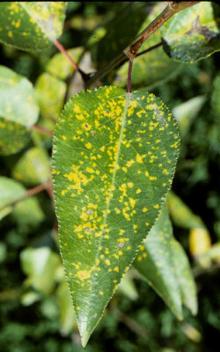See:
Fir, Douglas (Pseudotsuga menziesii) - Rust
Cause Several species of Melampsora can affect different Populus species in the Pacific Northwest. M. occidentalis affects Populus trichocarpa, or native black cottonwood, but generally not interspecific hybrids; M. medusae (formerly M. albertensis) affects aspen; Melampsora x columbiana, the hybrid of introduced M. medusae and M. occidentalis affects hybrid cottonwoods and some populations of P. trichocarpa in the region; and Eurasian M. laricis-populina can affect many hybrid cottonwoods, Lombardy poplars, and black cottonwoods. On hybrid cottonwoods, leaf rust is most typically caused by the now widespread M. x columbiana. Although M. laricis-populina has potential to damage a number of poplars and cottonwoods, in the Northwest its distribution still is restricted. It is much more widely distributed in California.
Melampsora rust fungi overwinter as telia on fallen poplar leaves. In spring, the telia produce basidiospores, which infect the current-season needles of conifer hosts. Most commonly the coniferous aecial host is Douglas-fir, but species of Larix (larch) also host poplar-infecting Melampsora. Pine seedlings can be infected if artificially inoculated with basidiospores but pines near hybrid poplar plantations are not known to host poplar-infecting Melampsora. Yellow aecia develop on the needles, and the wind disperses aeciospores to nearby poplars. Uredinia then develop on the poplar host. Humid or moist conditions favor urediniospore production. Wind can disperse urediniospores long distances. Under optimal conditions, Melampsora species may undergo multiple cycles on the poplar uredinial host until leaf abscission. In late summer, telia begin to form in place of uredinia. M. laricis-populina also has been reported to overwinter as uredinial mycelia in evergreen poplars.
Repeated early leaf loss due to rust can reduce growth and yield during the following growing season. Susceptible clones may be predisposed to winter injury.
Symptoms In midsummer, small bright-yellow to orange pustules (uredinia) develop on the top, bottom, or both surfaces of leaves, depending on the species of Melampsora. An angular yellow area may be on the side of the leaf opposite the pustule. Heavy infections may cause defoliation and may lead to a premature, fall budbreak or predispose trees to other diseases and to cold damage. In autumn, black angular areas (telia) develop in infected tissue.
Cultural control
- Keep susceptible conifers 500 yards away from poplar stock.
- If possible, plant only hybrid poplar clones resistant to leaf rust, particularly that caused by M. x columbiana. Plantings should be regularly monitored since pathogenic variation is now common in the rust population.
Chemical control Effective if applied shortly after rust appears.
- Armada 50 WDG at 3 to 9 oz/100 gal water. Do not use a silicone-based surfactant. Not for nursery or greenhouse use. Group 3 + 11 fungicide. 12-hr reentry.
- Bonide Fung-onil Multi-purpose Fungicide at 2.25 teaspoons/gal water. Group M5 fungicide. H
- Daconil Weather Stik at 1.38 pints/100 gal water. Group M5 fungicide. 12-hr reentry.
- Eagle 20 EW at 6 to 12 oz/100 gal water for nurseries or landscapes. Group 3 fungicides. 24-hr reentry.
- Propiconazole-based products. Group 3 fungicides.
- Banner MAXX at 16 fl oz/100 gal water. 12-hr reentry.
- Infuse Systemic Disease Control at 0.5 Tbsp/gal water. H
- ProCon-Z at 16 oz/100 gal water. 24-hr reentry.
- Rally 40 WSP at 4 to 6 oz/A. Nursery or forest-area use only. Group 3 fungicides. 24-hr reentry.
References Newcombe, G., Stirling, B., McDonald, S.K., and Bradshaw, Jr., H.D. 2000. Melampsora x columbiana, a natural hybrid of M. medusae and M. occidentalis. Mycological Research 104: 261-274.
Newcombe, G., Stirling, B., and Bradshaww, Jr., H.D. 2001. Abundant pathogenic variation in the new hybrid rust population of Melampsora x columbiana on hybrid poplar. Phytopathology 91:981-985.



